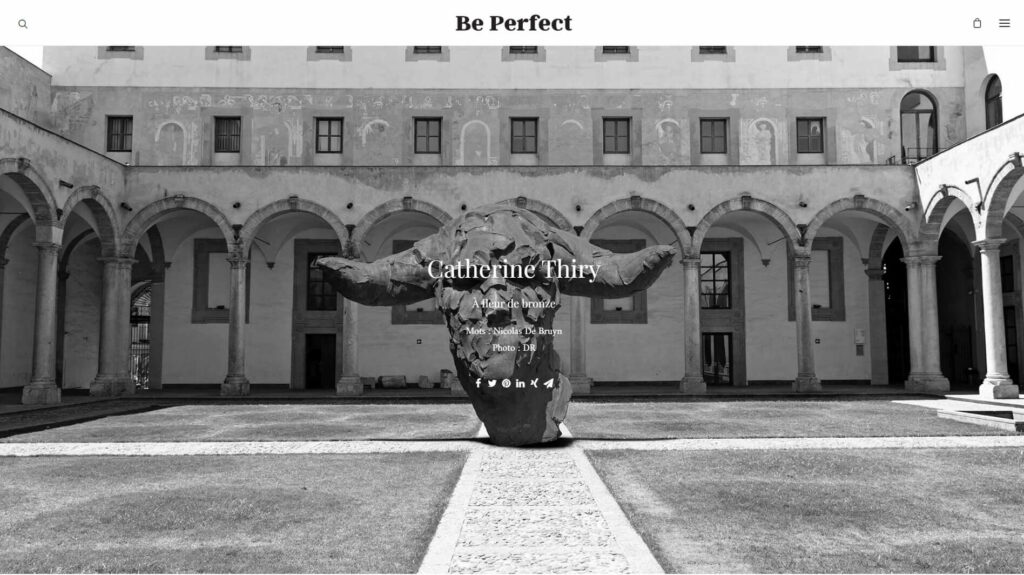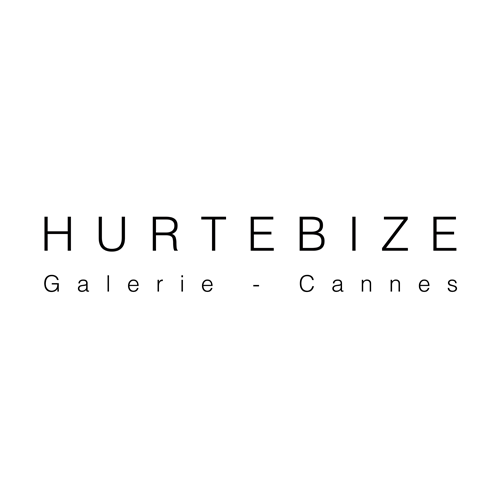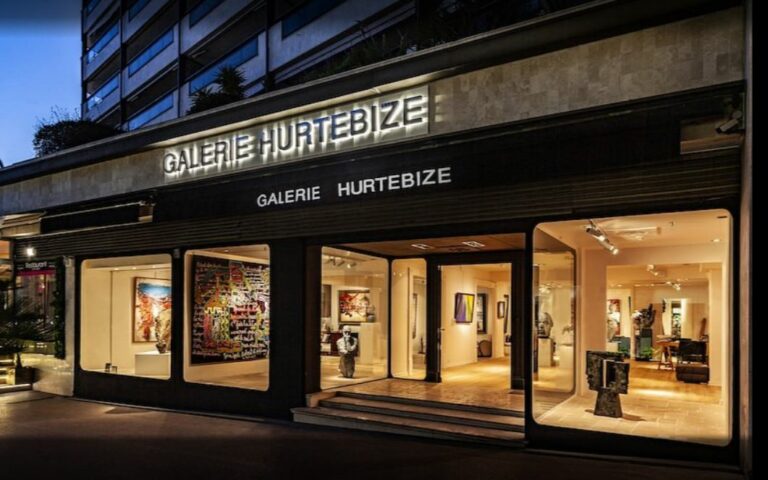They are talking...
- Nicolas Debruyn
- Marie Cambas
- Madinette Adam
- Muriel de Crayencour
Catherine Thiry

Strength, energy and grip are the first words that come to mind when talking about Catherine Thiry’s often monumental sculptures. In her work, however, it is the quivering of the surfaces that reaches us, and the unspeakable emotion that each being sketched out by her hands experiences.
I would like to know how you became an artist… Did you decide to?
I don’t know if this is decided, or even how to define art… For me, it is an action that allows me to accept reality. I try to respond through gesture to the questions that cross my mind, and to search endlessly for the absolute form.
At the beginning of my career as a painter, I simply wanted to use a skill I had in drawing to create a better life for myself.
Indeed, from the age of 16, in order to be autonomous, I worked in the equestrian field. From pony clubs to racing stables, I spent almost 10 years there.
And one day I remembered that I could draw. So I proposed to the people around me, portraits of their animals. Without any artistic intention or pretension, I found a way to support myself. It worked very well for years, and as time went by, I learned to paint better.
Slowly, the colours on my palette became the fuel of my imagination. Experimenting on the canvas gave me so much energy that I ended up seeking only this source of joy!
Luckily, an audience followed me, and thanks to this support I was able to stop doing portraits, and really listen to my aspirations.
Modelling is a natural consequence of this evolution. I also find my painterly touch in the texture of my sculptures.
Let’s talk about this amazing and singular texture, this movement that you imprint in the earth, like a living memory.
The imprint is touching, it makes you want to plunge your hands into the earth, so spontaneous and joyful does this gesture seem in your work.
Yes, it’s a pleasure and a game with light. I need the texture to hold on to it.
Like a painter looking for a simple trace that can evoke the right feeling! In the studio, I only validate sculptures that move me, the only reference is my own sensation.

Throughout your progression, which artists have moved you the most?
I have always loved painters like Rik Wouters, Vincent Van Gogh… but I was really transported by Marc Rothko’s paintings. It was as if every tiny nuance of his paintings spoke directly to me about what I was experiencing. The vibration that emanates from them reaches the depths of my being.
Francis Bacon was also an extraordinary discovery. It was as if I could enter his paintings and travel in consciousness.
I was rarely touched by sculpture, until one day I saw a work by Henry Moore. I remember standing in a crowd at TEFAF and not being able to take my eyes off that sculpture. I understood how shapes could talk to each other and to the air around them. Moved to tears, I felt myself becoming those forms. At that moment I knew that the path of creation would be long and exciting!
LES MAINS DE CATHERINE THIRY

Catherine Thiry’s sensual and spontaneous work is born from the meeting of the sculptor’s hands with the clay. It is in this tactile dialogue that she draws her inspiration; “I do not choose my subjects, they impose themselves”, she confides to us. Catherine models the clay according to her very particular technique, made of repeats, thicknesses and irregularities that enhance the materiality of the work. Once the gesture is complete, the artist entrusts her work to her partner foundry. The latter uses the lost wax process to faithfully render the beautiful accidents of the modelling, in a bronze that seems to be animated. Asperities, volumes and even the artist’s fingerprints appear, testimony to the magical encounter between his hands and the clay.
When the work is born, Catherine does not know what will emerge from the earth. She says:
What is expressed is beyond words and my conditioning. I only listen to my sensations and I try to avoid as much as possible having an opinion, a thought or a judgment on the result.
It is the gesture that guides me towards what is new at each moment, life!
And the dance with the earth leads me to a place where nothing else matters except the intensity of the present.
The title comes afterwards, because I don’t know everything that will be said during the creation… As Edward Hopper said: “If you could say it in words, there would be no reason to paint it.
To give a name, a title to what is played out in the heart of the studio is derisory in my eyes.
I just try not to spoil the feeling I had the joy of knowing, living this experience. I would like the work to induce only questions towards ourselves, I do not wish to give explanations.
A painter whose name I have forgotten said: “When a work needs an explanation… often the explanation does not need the work”.
Catherine Thiry thus offers for each creation a concentrate of life, emotions and instincts; a fragment of infinity, as she herself suggests. Her art is above all empirical and rooted in a search for the sensitive.
The Hurtebize Gallery has chosen to defend the beauty of her poetics by offering several pieces by the artist: busts, such as Sagace and Panacea, portraits, such as Le Kid, Effigy or Ma Parole, but also other types of work, such as Paradigm, Tempera and Lucid. These three sculptures tell the story of human feeling through the use of the animal figure. All these pieces are original bronzes, whose shape, size and patina have been carefully worked out by their creator.
Come and discover our exhibition route where the works of the masters of lyrical abstraction – Hans Hartung, Georges Mathieu, Pierre Soulages, John Levée, Jean Miotte, Jacques Germain – harmonise and interact in perfect union with Catherine Thiry’s sculpture floor. Thiry is a sculptor of intensity, of strong gesture, just as the lyricists opened the way to the painting of the sensitive self through a specific gesture. It is this same desire for freedom of expression and universalism that coordinates the dialogue between the modern works and the contemporary sculptures of the Galerie Hurtebize.
Marie Cambas
Hurtebize Gallery – 2019

Catherine has injured hands, a hard worker,
of an ancient washerwoman.
They dance before you when she speaks.
She crushes them when she weaves the wired carcass, which will be the bone
and thread of the new thing she is raising from the earth.
She holds them warm to approach the clay she tortures
and caresses. She ties them on the neck, the back, the stomach and the cheeks
of what comes out of her fingers: the lively, the beautiful, the warm.
I have never seen Catherine “working”,
I can only imagine her letting her pretty square hands
I can only imagine her letting her pretty square hands tell me how happy they are to “do”.
Catherine sculpts and paints. She sculpts as she paints
and makes the opposite way from the eye to the hand.
Her bursts of life, almost monochrome on canvas, must be allowed to shatter into bronze,
brutally chipped in bronze, emerge from her and invade your eye,
the heart and the hand that reaches out to touch
the raw caress she has given them
with her brush, her fingers and sometimes her fists.
Catherine is a force of nature,
who embraces the forms that have been germinating in her
since childhood.
She is free to twist or stretch them as she pleases
because she has never learned, she has watched. Horses, first of all.
For as long as she can remember they were there, brushing against her,
taming her and pushing her to her limits.
From them came the strength, the eye and the hand
to put their colours and senseless movements outside of her
which, with a stroke of the brush, became her own.
From them came the gesture, the assurance and the accuracy
to model her idea of earth and sky and to cast
his image in the bronze that seems to be dented.
These aligned pegasus are her mentors, her life guides, her freedom.
Catherine looks like nothing, she invents.
With a gesture, she captures the suspended movement of a man
doubt hurts, the intimate conviction of a “little one”,
the infinite step of a tiny pony or the distant gaze of a “cador
of which it delivers only the emerging head.
It seems to me that it goes from a push to a pull, and probably also to a punch,
she taps the earth, twists it, plates it, makes a carapace of it
that sheathes the tightrope walker moment that her eye has captured.
Strangely, the transition to bronze sublimates this instantaneousness.
She never falls into repetition or automatism.
Her freedom amazes and touches me.
Catherine paints, and her painting resembles her well.
Free and moving, moving,
like the looks she details, veils or deliberately erases.
Here too, the horses are not horses.
They rush in, drown and powder in the brightness of primal colours,
when human faces emerge, question
or sink into the same deep, crazy hues.
She holds a maddening red, a shocking blue
that I want to call a centaur!
I have a memory of a sea-belly blue for a “Somewhere”,
a horse that has unfortunately vanished since it has been sold…
Catherine sculpts and paints, straight to the heart.
She puts her blue to the soul, but brandishes fire and flames
without fear, in total freedom.
For there is joy in her art and a penetrating strength,
which emerge from her and take hold of the throat like a child’s sorrow.
I have nothing more to say in words,
I want to let her unheard-of working hands
move heaven and earth
and let her fingers
touch the heart of the colour of time.
Sculpting. Effortlessly. Mounting a silhouette in clay. This is what Catherine Thiry does. The work of this self-taught artist can be discovered at The Latem Gallery in Sint-Martens-Lathem until the end of November, but also all year round at the Macadam Gallery in Brussels.
What is a figure if not a structure, a skeleton on which muscles, tendons and flesh are fixed? What is a sculpture if not this same underlying structure? It is the ability to understand and reproduce the rigid structure that underlies all form that makes the sculptor. If this structure is not present, or at least thought of by the artist, the work does not stand. Catherine Thiry has this ability. A head. Skin and flesh on the hard surface of the skull. A horse, such a complex skeleton, graceful but powerful. A young woman, sinuous yet sustained line… They are there, before our eyes, born of the artist’s skill, in clay, in large additions of material, like brushstrokes. Thus, the volume is born from a set of lines that play with light and shadow. This makes the surface alive and vibrant. These silhouettes are then cast in bronze or another metal.
Beyond the vibrant form, the palpitating surfaces, it is the emotion that prevails. From serenity to anger, shyness, introspection, fear, restraint, pride, a whole range of emotions emerge from each of Catherine Thiry’s sculptures. Underneath their classical appearance, her sculptures tell us about our common deep humanity.
Muriel de Crayencour
http://mu-inthecity.com/2016/11/catherine-thiry-palpitations/

